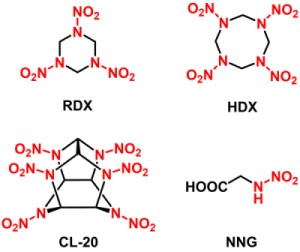
Nitramine functionalities are critical explosophores for the compounds RDX, HMX, and CL-20, which are components of a wide range of military munitions and ordnance. RDX and HMX are common components of military-grade plastic explosives while CL-20 is used as a missile propellant. The manufacture and detonation of these compounds causes them to inevitably leach into the environment, including drinking water supplies. Acute exposure to nitramines results in violent convulsions, and RDX is listed by the United States EPA as a possible carcinogen. Furthermore, nitramines are reduced in the environment to nitrosamines, which are highly carcinogenic. Nitramines released from explosives persist in the soil and in groundwater; dissolved RDX, HMX, and CL-20 exhibit half-lives ranging from 94 to over 2000 days, requiring the development of efficient degradation methods. Several microbial species have been identified that degrade these compounds. RDX decomposition by the cytochrome P450 homolog, XplA, has also been well studied. A bioremediation strategy has been engineered based on these studies, but cannot completely degrade the nitramine functionalities; a linear nitramine, 4-nitro-2,4-diazabutanal (NDAB), is generated as a product of XplA activity
We are studying degradation of a nitramine-containing compound called N-nitroglycine (NNG) by a heme-containing enzyme called NnlA. The objective of our current work is to determine the NNG-decomposition mechanism of NnlA and use the mechanistic information to engineer NnlA to degrade linear nitramines, such as NDAB. The long-term goal is to complement extant bioremediation techniques of military-grade explosives. From this project, we will characterize novel metallointermediates as well as radical species broadly relevant to nitramine detonation. Importantly, the research is expected to inform bioremediation strategies of nitramines.